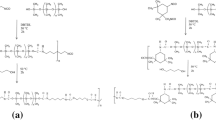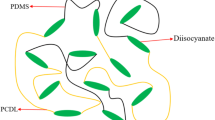Abstract
The effect of non-polar and non-hydrogen bonding hydroxybutane terminated polydimethylsiloxane (PDMS) on the microstructure and properties of polycaprolactone glycol (PCL) based thermoplastic polyurethane (TPU) was studied. All processes were based on the ontology method. FTIR, XRD, DSC and DMA were used to characterize the changes of microstructure, and the macroscopic properties were tested by mechanical, contact angle and flame retardancy testing. PDMS would increase the microphase separation, which made the system form a more detailed three-phase structure. PDMS would cause great damage to the mechanical properties, but the hydrophobicity and flame retardancy would be improved to varying degrees.










Similar content being viewed by others
References
Xiao S, Sue HJ (2019) Effect of molecular weight on scratch and abrasive wear behaviors of thermoplastic polyurethane elastomers. Polym J 169:124–130
Huang A, Peng X, Turng LS (2018) In-situ fibrillated polytetrafluoroethylene (PTFE) in thermoplastic polyurethane (TPU) via melt blending: Effect on rheological behavior, mechanical properties, and microcellular foamability. Polym J 134(1):263–274
Xu XH, Fan PD, Ren J et al (2018) Self-healing thermoplastic polyurethane (TPU)/polycaprolactone (PCL)/multi-wall carbon nanotubes (MWCNTs) blend as shape-memory composites. Compos Sci Technol 168(NOV.10):255–262
Jing X, Mi HY, Huang HX et al (2016) Shape memory thermoplastic polyurethane (TPU)/poly(ε-caprolactone) (PCL) blends as self-knotting sutures. J Mech Behav Biomed Mater 64:94–103
Chen X, Chen X, Li S et al (2021) Copper metal, rganic framework toward flame-retardant enhancement of thermoplastic polyurethane elastomer composites based on ammonium polyphosphate. Polym Adv Technol 32(8):2829–2842
Belva F, Bourbigot S, Duquesne S et al (2010) Heat and fire resistance of polyurethane polydimethylsiloxane hybrid material. Polym Adv Technol 17(4):304–311
Joki-Korpela F, Pakkanen TT (2011) Incorporation of polydimethylsiloxane into polyurethanes and characterization of copolymers. Eur Polym J 47(8):1694–1708
Adhikari R, Gunatillake PA, Bown M (2010) Effect of polydimethylsiloxane macrodiol molecular weight on properties and morphology of polyurethane and polyurethaneurea. J Appl Polym Sci 90(6):1565–1573
Ghanbari H, Viatge H, Kidane AG et al (2009) Polymeric heart valves: new materials, emerging hopes. Trends Biotechnol 27(6):359–367
Wang Z, Yang Y, Burtovyy R et al (2014) UV-induced self-repairing polydimethylsiloxane-polyurethane (PDMS-PUR) and polyethylene glycol polyurethane (PEG-PUR) Cu-catalyzed networks. J Mater Chem A 2(37):15527–15534
Chen R, Chang C, Chang Y (2005) Study on siloxane-modified polyurethane dispersions from various polydimethylsiloxanes. J Polym Sci Part A Polym Chem 43(16):3482–3490
Wu Z, Wang H, Tian X et al (2014) The effects of polydimethylsiloxane on transparent and hydrophobic waterborne polyurethane coatings containing polydimethylsiloxane. Phys Chem Chem Phys 16(14):6787–6794
Zhao H, Zhao SQ, Li Q et al (2020) Fabrication and properties of waterborne thermoplastic polyurethane nanocomposite enhanced by the POSS with low dielectric constants. Polym J 209(3):122992
Yen MS, Tsai PY, Hong PD (2006) The solution properties and membrane properties of polydimethylsiloxane waterborne polyurethane blended with the waterborne polyurethanes of various kinds of soft segments. Colloids Surf A 279(1–3):1–9
Zhang ZP, Song XF, Cui LY et al (2018) Synthesis of polydimethylsiloxane modified polyurethane and the structure and properties of its antifouling coatings. Coatings 8(5):157
Yilgor I, Eynur T, Yilgor E et al (2009) Contribution of soft segment entanglement on the tensile properties of silicone-urea copolymers with low hard segment contents. Polym J 50(19):4432–4437
Askari F, Barikani M, Barmar M (2013) Siloxane-based segmented poly (urethane-urea) elastomer: Synthesis and characterization. J Appl Polym Sci 130(3):1743–1751
Yilg RI, Yilg RE, Wilkes GL (2015) Critical parameters in designing segmented polyurethanes and their effect on morphology and properties: A comprehensive review. Polym J 58:A1–A36
Choi T, Weksler J, Padsalgikar A et al (2009) Influence of soft segment composition on phase-separated microstructure of polydimethylsiloxane-based segmented polyurethane copolymers. Polym J 50(10):2320–2327
Yang J, Gao Y, Li J et al (2013) Synthesis and microphase separated structures of polydimethylsiloxane/polycarbonate-based polyurethanes. RSC Adv 3(22):8291–8297
Choi T, Weksler J, Padsalgikar A et al (2010) Microstructural organization of polydimethylsiloxane soft segment polyurethanes derived from a single macrodiol. Polym J 51(19):4375–4382
Pedrazzoli D, Manas-Zloczower I (2016) Understanding phase separation and morphology in thermoplastic polyurethanes nanocomposites. Polym J 90:256–263
Chan B, Liow SS, Xian JL (2016) Organic-inorganic shape memory thermoplastic polyurethane based on polycaprolactone and polydimethylsiloxane. RSC Adv 6(41):34946–34954
Brunette CM, Hsu SL, Macknight WJ, Schneider NS (1981) Structural and mechanical properties of polybutadiene-containing polyurethanes. Polym Eng Sci 21(3):163–171
Senich GA, Macknight WJ (1980) Fourier transform infrared thermal analysis of a segmented polyurethane. Macromolecules 13(1):106–110
Stanciu A, Airinei A, Timpu D et al (1999) Polyurethane/polydimethylsiloxane segmented copolymers. Eur Polymer J 35(11):1959–1965
Zawadzki SF, Akcelrud L (2015) HTPB-based Polyurethanes: a correlation study between morphology and mechanical behaviour. Polym Int 42(4):422–428
Acknowledgements
This work was supported by the Natural Science Foundation of Shandong Province (project No.: ZR2020QE072); and the Qingdao Key R&D Program (project No.: 21-1-2-8-cl).
Author information
Authors and Affiliations
Corresponding author
Ethics declarations
Conflict of interest statement
The authors declare that they have no known competing financial interests or personal relationships that could have appeared to influence the work reported in this paper.
Additional information
Publisher's Note
Springer Nature remains neutral with regard to jurisdictional claims in published maps and institutional affiliations.
Rights and permissions
About this article
Cite this article
Cui, Y., Pan, H., Zhang, J. et al. Influence of polydimethylsiloxane on the microstructure and properties of polyester thermoplastic polyurethane. J Polym Res 29, 218 (2022). https://doi.org/10.1007/s10965-022-03079-2
Received:
Accepted:
Published:
DOI: https://doi.org/10.1007/s10965-022-03079-2




